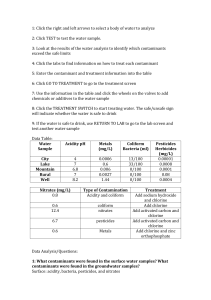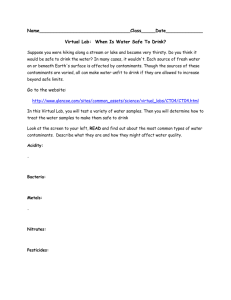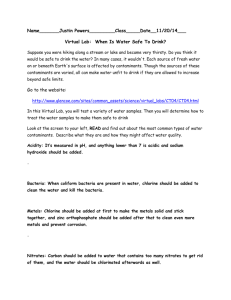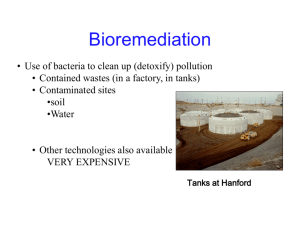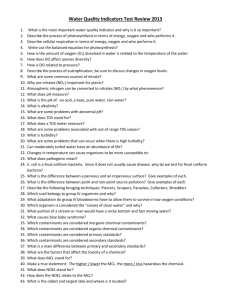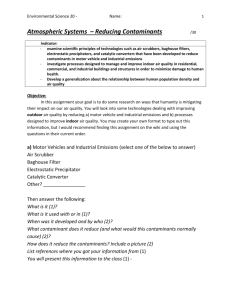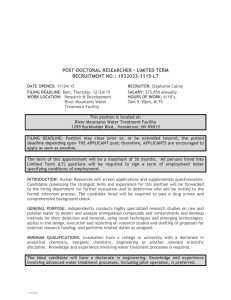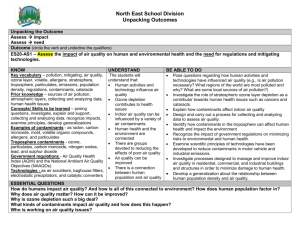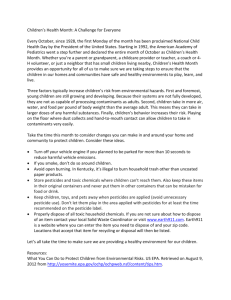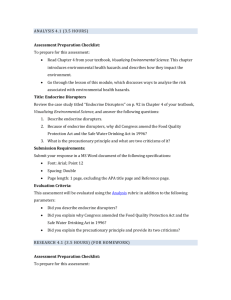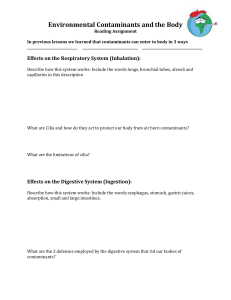File
advertisement
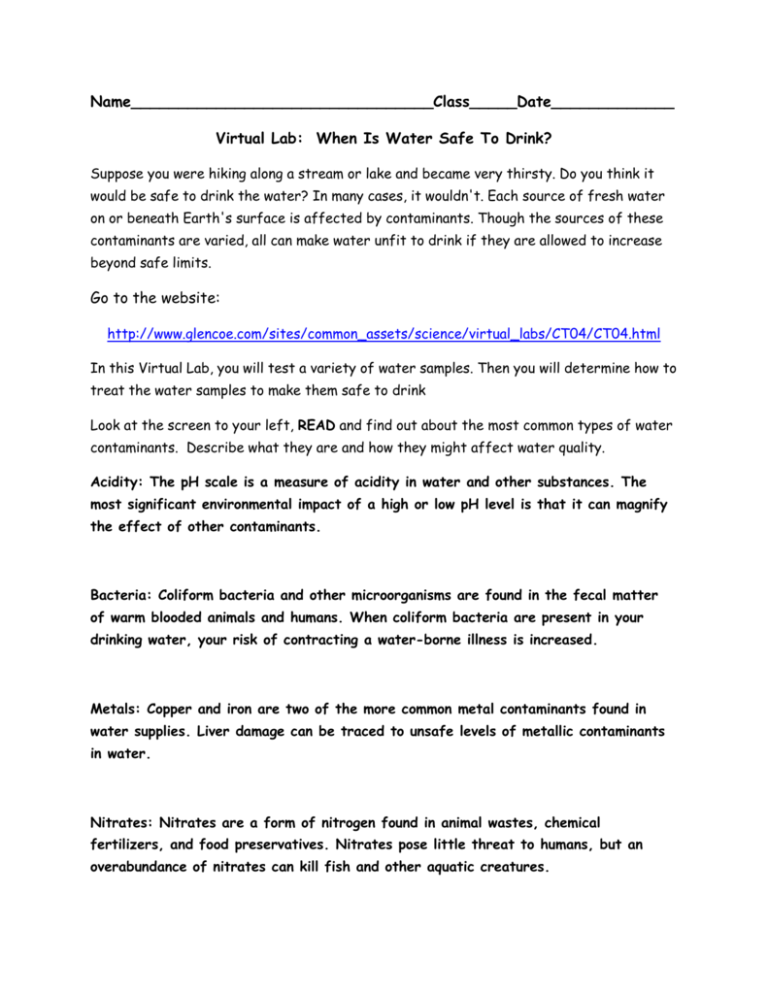
Name________________________________Class_____Date_____________ Virtual Lab: When Is Water Safe To Drink? Suppose you were hiking along a stream or lake and became very thirsty. Do you think it would be safe to drink the water? In many cases, it wouldn't. Each source of fresh water on or beneath Earth's surface is affected by contaminants. Though the sources of these contaminants are varied, all can make water unfit to drink if they are allowed to increase beyond safe limits. Go to the website: http://www.glencoe.com/sites/common_assets/science/virtual_labs/CT04/CT04.html In this Virtual Lab, you will test a variety of water samples. Then you will determine how to treat the water samples to make them safe to drink Look at the screen to your left, READ and find out about the most common types of water contaminants. Describe what they are and how they might affect water quality. Acidity: The pH scale is a measure of acidity in water and other substances. The most significant environmental impact of a high or low pH level is that it can magnify the effect of other contaminants. Bacteria: Coliform bacteria and other microorganisms are found in the fecal matter of warm blooded animals and humans. When coliform bacteria are present in your drinking water, your risk of contracting a water-borne illness is increased. Metals: Copper and iron are two of the more common metal contaminants found in water supplies. Liver damage can be traced to unsafe levels of metallic contaminants in water. Nitrates: Nitrates are a form of nitrogen found in animal wastes, chemical fertilizers, and food preservatives. Nitrates pose little threat to humans, but an overabundance of nitrates can kill fish and other aquatic creatures. Pesticides: Pesticides and herbicides are manufactured chemicals that are used to kill weeds, molds, and insects. In concentrated amounts, these substances can cause a number of health problems, including anemia, and liver and kidney disorders. Objectives: 1. ·Define types of water contaminants. 2. ·Determine which types of contaminants are common to lake water, city water, well water, rural water and mountain water. 3. ·Identify treatments that remove contaminants from drinking water. Procedure: 1. Click the right and left arrows to select a body of water to analyze. 2. Click Test to test the water sample. 3. Look at the results of the water analysis. Identify the “Safe Range” for each category and record this in the data table. 4. Identify which contaminants exceed the safe range. 5. Click the tabs to find information on how to treat each contaminant. 6. Enter the contaminant and treatment information in your data table. 7. Click Go To Treatment to go to the treatment screen. 8. Use the information in the table and click the wheels on the valves to add chemicals or additives to the water sample. 9. Click the Treatment Switch to start treating the water. The Safe/Unsafe Sign will indicate whether the water is safe to drink. 10. If the water is safe to drink, use Return to Lab to go to the lab screen and test another water sample. 11. If the water is unsafe to drink, check your information and treat the water sample again. 12. When you have tested and treated all the water samples, use your completed table to complete the analysis questions. Analysis 1. What contaminants were found in the surface water samples? Bacteria, pesticides and nitrates. What contaminants were found in the groundwater samples? Bacteria pesticides and metals. 2. Why might groundwater and surface water have different contaminants? Well humans have a bigger Impact on surface water since we walk in it all the time. Groundwater we still have an impact but we don’t walk in it, dive in it or play in it every day. 3. Generally, farmers do not farm on the sides of mountains or in remote areas. Industries also do not build factories in these areas. These areas are usually not highly populated by people. What might explain the high nitrate level in the mountain water in this activity? The runoff runs down into our streams and that is how we have high nitrate levels in the mountains. 4. What is pH level, what are its characteristics, and how does it contribute to pollution? Water with a pH reading of zero to six, or acidic water, is unsafe to drink and can corrode metal pipes. The pH scale is a measure of acidity in water and other substances. It helps us tell if we have a to high acidity. What chemicals are used in treating low pH levels? Sodium hydroxide. Critical Thinking-Please read this carefully! Water in an old building tested recently, showed high copper and iron content, and low pH levels. A water reading taken 20 years before, showed low pH levels and only minimal traces of copper and iron. If none of the new buildings on the same street showed signs of metallic contaminants, but all reported lower than normal pH readings, how might these readings be explained? The most significant environmental impact of a high or low pH level is that it can magnify the effect of other contaminants. The pH levels cause the building to have a high copper an iron level. The pH levels lead to other problems. Sample Acidity (pH) Metals (mg/L) Coliform Bacteria (ml) O per 100 ml Pesticides/Herbicides (mg/L) Nitrates Safe Range 6.5-8.5 City 4 Less than 1.3 mg 0.0006 mg Lake 7 Mountain Rural Type of Contamination Treatment Performed Less than 0.04 mg 13/100 ml 0.00001 mg Less than 10.0 mg 0.8 mg Bacteria and acidity It has to be chlorinated and should add sodium hydroxide It should be chlorinated and add activated carbon Add activated carbon during the treatment process and should be chlorinated Add activated carbon 0.6 mg 33/100 ml 0.0008 mg 0.6 mg Bacteria and pesticides 6.8 0.006 mg 0/100 ml 0.0001 mg 12.4 mg Nitrates 7 0.0027 mg 0/100 ml 0.08 mg 6.8 mg Pesticides Well 8.2 1.44 mg 0/100 ml 0.0004 mg 0.6 mg Metals and Pesticides during the treatment process Add activated carbon during treatment process and add chlorine at the beginning and zinc at the end
